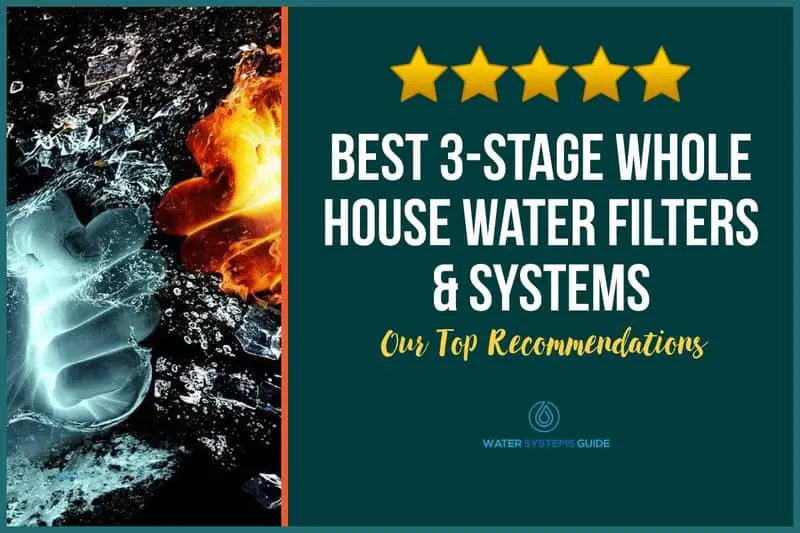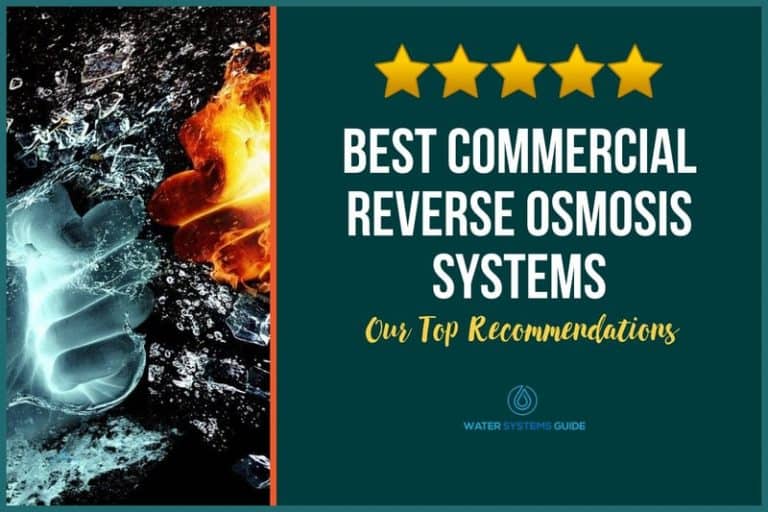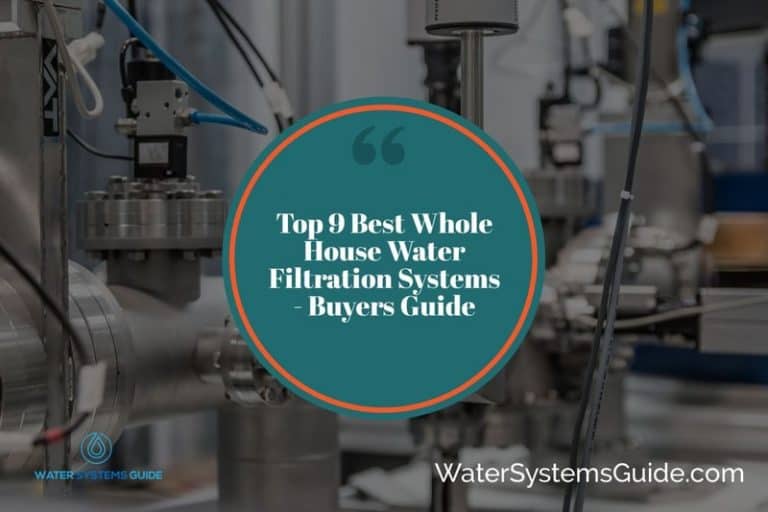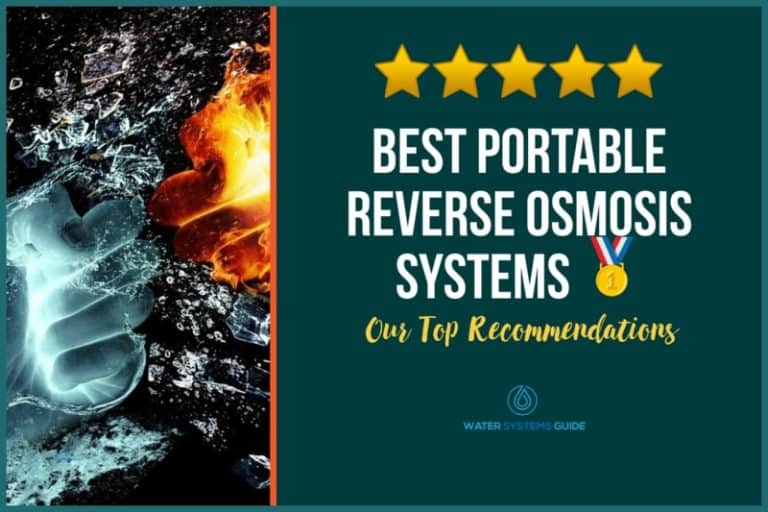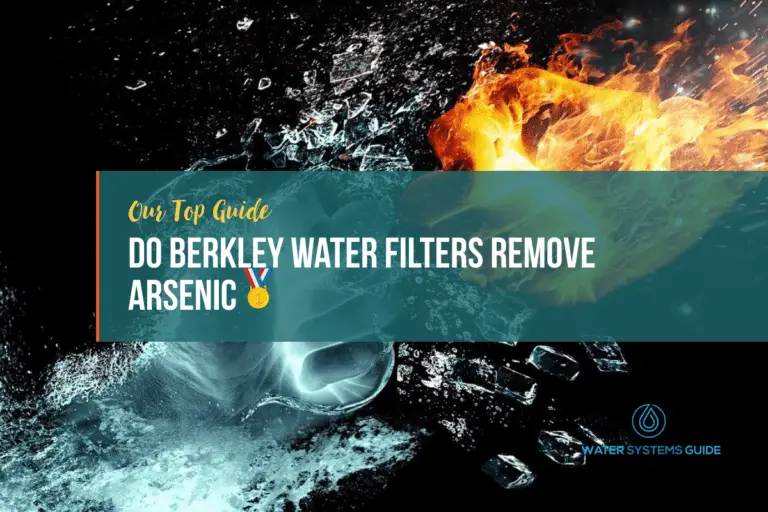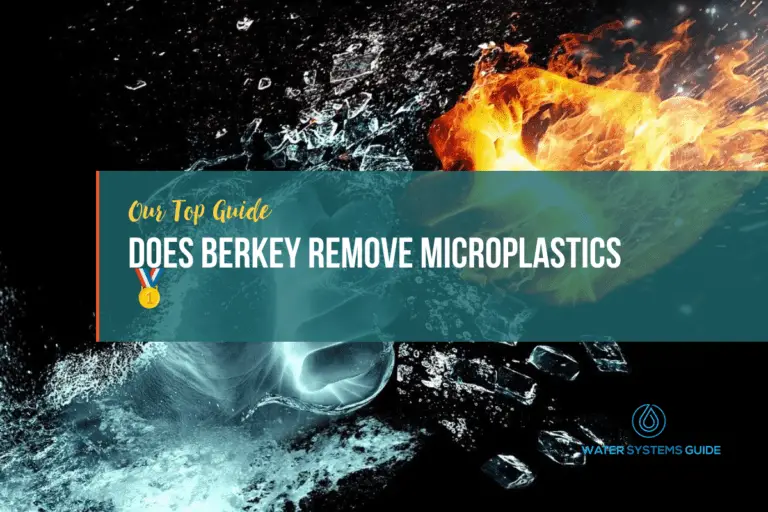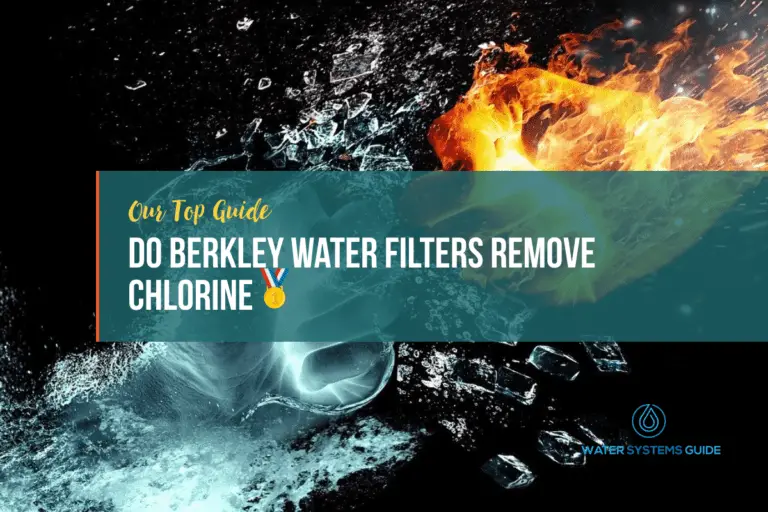5 Best 3-Stage Whole House Water Filters & Systems (January 2026)🥇
Last Updated: 01 January 2026
In this article, we’re going to be talking about the best 3-Stage Whole House Water Filter Systems from your water supply, which are available on the market.
In addition to removing pollutants from your potable water, the three-stage whole house water filtration systems also improve the smell and the taste of the same. On top of that, it reduces water’s hardness to make sure that it gives you a healthy-looking hair and skin, and leaves fewer stains on your dishes.
That said, not all house water filter systems are created equal.
That means that if you want to get the best home water filtration system, what you need is someone to identify the features which separate the best units from the also-rans. At the same time, you need to have one eye on your budget to make sure that you get good value for your money.
Think that’s something that’s beyond you? Don’t worry as this article will help you out.
✅What is a whole house water filter system?
As the name implies, a whole house water filter system removes impurities, pollutants, and other harmful substances from the tap water of your home.
It is able to do that by installing a point-of-entry system which works by channeling all the water through a filtration media.
That means that in contrast to, say, undersink water filter systems, you won’t see multiple water filters of the same whole house system throughout your house. Instead, it has a standalone water filter that gets the job done on its own.
Best 3-Stage Whole House Water Filters Review – Top 5
- Spring WCB32C 3-Stage Whole Water Filtration System – 30,000 Gal – $ – Skip to section
- iSpring WGB32B 3-Stage Whole House Water Filter – 100,000 Gal – $$$ – Skip to section [#1 Recommendation – Highly Affordable, 3-Stage Filter, 99% Cl & F− Removal]
- Express Water Whole House Water Filter – 100,000 Gal – $$$ – Skip to section
- Apex 3-Stage Whole House Water Filter – 20,000 Gal – $$$$ – Skip to section
- Express Water 3 Stage Whole House Water Filter System – $$$$ – Skip to section
iSpring WCB32C 3 Whole Water Filtration System – $
The iSpring WGB32B filter is for those of you who are satisfied with the performance of the manufacturer’s 2-stage filters but want more protection for your household against contaminants which the first 2 stages can’t keep out.
Technical Specs
- Filter Stages: 3
- Micron: 5
- Rate: 12GPM
- Capacity: 30,000 Gal
- Fluoride & Chlorine Removal: Up to 95%
General Specs
- Price: $
- Dimensions: 17 x 7 x 25 inches
- Weight: 22.3 pounds
- Kit includes: 3-stage filter system, filter cartridge x 3
- Warranty: 1-year
Features
The WCB32 whole house filtration system is the ideal “point of entry” filtration system for cleaning up water supplies to a home or business on municipal (city) water. Unlike “point of use” systems (like reverse osmosis systems) that are installed to supply water to a specific faucet, the WCB32 filters your water from the source.
Pros
- 3-stage filtration
- Eliminates herbicides, pesticides, and VOCs (95% efficiency)
- Affordably priced
- All three cartridges meet ANSI/NSF standards
Cons
- You get what you pay for, this is a budget system
iSpring WGB32B 3-Stage Whole House Water Filter – $$$
#1 Recommendation – Highly Affordable, 3-Stage Filter, 99% Cl & F− Removal
The iSpring WGB32B filter is for those of you who are satisfied with the performance of the manufacturer’s 2-stage filters but want more protection for your household against contaminants which the first 2 stages can’t keep out.
Technical Specs
- Filter Stages: 3
- Micron: 5
- Rate: 15GPM
- Capacity: 100,000 Gal
- Fluoride & Chlorine Removal: Up to 99%
General Specs
- Price: $$$
- Dimensions: 21 x 8 x 28 inches
- Weight: 49 pounds
- Kit includes: 5″ x 20″ 5 Micron High-volume Polypropylene Residues Filter (FP25B), 4.5″ x 20″ 5 Micron CTO Block Filter (FC25B), Filter housing wrench and user manual, water filtration system
- Warranty: 1-year
Features
Of the 3 individual filters which this unit comes with to keep your household safe, the first one focuses on removing residues, silt and similar dirt particles from your house water. The second filter, whose internals are made of carbon black, rids your water of taste, odor, herbicides, and VOCs.
As for the 3rd stage, it completes the process started by the 2nd stage filter. Any contaminants which were able to bypass the 2nd stage would be caught here, and since this unit has the same carbon block filter as that of its predecessor, it will send the pollutants to oblivion.
Moreover, this filter demolishes the myth that multi-stage filters can’t provide a decent rate. It provides the same 15GPM flow rate which its 2-stage counterparts provide and can handle a formidable volume of up to 100,000 gallons.
Lastly, when the time comes to replace the filter, you won’t have to expend much time and effort to do the need. All you would have to do is to just open the filters’ casing with the supplied wrench, twist off the existing filter, twist on the new one and you’d be good to go.
Pros
- 3-stage filtration
- Eliminates herbicides, pesticides, and VOCs
- Filters are easy to replace
- All three cartridges meet ANSI/NSF standards
Cons
- Residues filter might last less long
Express Water Whole House Water Filter – $$$
Who says 3-stage water filters cannot compete with their 2-stage counterparts when it comes to flow rate and volume it can handle? With the Express Water Whole House Water Filter, you can see for yourself that in contrast to what most people believe, you can have the best of both worlds.
Technical Specs
- Filter Stages: 3-stages
- Micron: 5
- Rate: 15GPM
- Capacity: 100,000 Gal
- Fluoride & Chlorine Removal: Amount not displayed
General Specs
- Price: $$$
- Dimensions: 5 x 8.5 x 29.5 inches
- Weight: 8 pounds
- Kit includes: 3 filter cartridges, 1-inch connections, pressure gauges, etc, water filtration system
- Warranty: 1-year
Features
As you might have guessed by now, each of the 3 stages of this whole house water filter serves a specific purpose. While the first cartridge eliminates residues and other dirt particles, the 2nd filter would keep the likes of taste, odor, and chlorine from making their way into your faucets.
The 3rd part of this trinity has an activated black filter to protect against pesticides, herbicides, VOCs and all other chemicals. Add together the utility of all three cartridges, and what you get is water that is as safe for cooking as it is for drinking purposes.
Yet another great feature of this unit is the pressure gauge located on top of each cartridge. Equally impressive is the see-through design of the casings of all three cartridges, which allows you to monitor your system and see from outside when it’s time to replace the filter.
When the time has arrived to replace the cartridges, all you’d have to do is to simply twist off the housings with the drop-and-go design making filter change a cinch. Also, since the overall frame is capable of standing on its own, you don’t necessarily have to mount it.
Pros
- High capacity filtration
- See-through design
- Freestanding stainless steel frame
- Three pressure gauges
Cons
- Inlet and outlet connections are loose
Apex 3-Stage Whole House Water Filter – $$$$
The Apex 3-Stage whole house water filtration system is built for eliminating most impurities that can make their way into your municipal water. Also, since all three of its filters are housed in the same casing, it’s price-effective for the user to maintain them.
Technical Specs
- Filter Stages: 3
- Micron: 5
- Rate: 15GPM
- Capacity: 20,000 Gal
- Fluoride & Chlorine Removal: Amount not displayed
General Specs
- Price: $$$$
- Dimensions: 30 x 24 x 12 inches
- Weight: 2 pounds
- Kit includes: House water filtration system
- Warranty: 1-year
Features
In contrast to its single-stage counterparts, the Apex 3-Stage filter kicks off the process by removing large residues particles, followed by the removal of chlorine and chemicals in its 2nd stage. Then comes the 3rd pass of filtration which eliminates odors, smells and pungent substances from water.
Furthermore, none of the filters tamper with the rate and allow you to draw water at a rate of 15 gallons per minute. You can also keep on using the same cartridges for 6 months because all of them have the volume to handle 20,000 gallons.
What’s more, you don’t have to waste any time to try and install this unit since it comes 100% pre-assembled and ready to mount. Also, since this unit doesn’t employ reverse osmosis technology, you don’t need electricity to keep it running.
To further sweeten the deal, Apex has provided this unit with a 100% satisfaction and quality guarantee, which means that if for any reason you aren’t satisfied with its performance, you can either have the unit replaced or get a full refund.
Pros
- BPA-free materials
- Considerable rate
- Offers 100% satisfaction guarantee
Cons
- Relatively low capacity
Express Water 3 Stage Whole House Water Filter System – $$$$
The iSpring WGB32B filter is for those of you who are satisfied with the performance of the manufacturer’s 2-stage filters but want more protection for your household against contaminants which the first 2 stages can’t keep out.
Technical Specs
- Filter Stages: 3
- Micron: 5
- Rate: 12GPM
- Capacity: 100,000 Gal
- Fluoride & Chlorine Removal: Up to 99%
General Specs
- Price: $$$$
- Dimensions: 23.5 x 8.5 x 30 inches
- Weight: 65 pounds
- Warranty: 1-year
Features
Pros
- 3-stage filtration
- Eliminates herbicides, pesticides, and VOCs
- Excellent customer reviews
- Easy to install
- All three cartridges meet ANSI/NSF standards
Cons
- More expensive than other units
Conclusion
We realize that every reader will have different requirements from their ideal 3-stage whole house water filtration system, and this is why we’ve done our best to hight the features, technical specs, pros, and cons for each unit.
This makes it easier for you, the reader, to find the one that suits your needs and requirements.
With that being said, we particularly like this unit, when considering its features, impressive technical specs, customer review ratings and the price:
iSpring WGB32B 3-Stage Whole House Water Filter – 100,000 Gal – $$$ – Skip to section [#1 Recommendation – Highly Affordable, 3-Stage Filter, 99% Cl & F− Removal
Frequently Asked Questions
🚰How much is a 3 stage whole house water filter?
Based on our survey of the market and the prices of the products you see in this review, 3 stage whole house filtration drinking systems are available at prices ranging between $150 and $500.
💧How does a three-stage whole house water filter system work?
Before we introduce you to their working mechanism, you should know that not all whole home water filters have a similar working mechanism. In fact, apart from the first three steps of the below-mentioned procedure – which are common in almost all whole home filters – it is entirely possible that your system might not have the last three steps.
With this disclaimer, here’s how whole home water filter systems work:
Step #1: Sediments Pre-filter
In contrast to where you might be living, as long as you’re receiving water directly from your municipality, there’s a very good chance that it would contain sediments. A sediment filter would help in this situation.
Hence the reason why most multi-stage water filters have a sediments-pre filter which does exactly as its name implies. Apart from capturing sediments, it also keeps the likes of rust and silt at bay.
Step #2: Activated Carbon filter
Is your water giving off an unpleasant smell? That means it might contain excessive amounts of spent chlorine and fluoride. To remove both these pollutants, an activated filter comes into play.
By working on a process known as adsorption – which means that the impurities would be trapped on the surface of the pores – the activated filter removes impurities and chlorines from water.
Step #3: CU-Zn and Mineral-Stone filter
Provided your water contains chlorine and water-soluble heavy metals, both these substances will make their presence felt by developing scale on your dishes and algae inside your water pipes.
To ensure that you don’t have to deal with any of the abovementioned scenarios, the combination of copper-zinc and mineral stone filters removes chlorine and water-soluble heavy metals from your house water.
Step #4: Water-softer (optional)
Water which contains an excess amount of hard minerals tends to cause scale on the surface of your dishes. Having a water softener system, therefore, prevents this scenario from materializing.
Filters with a water softener alter the structure of hard minerals into a crystal structure, thereby preventing them from binding. That, in turn, reduces scale build-up by up to 99.6%.
Step #5: Sub-micron Post Filter (Optional)
Don’t get confused by its name as the sub-micron post-filter is another incarnation of the sediment filter which we discussed in the first step, with the only difference lies in the size of particles it filters out.
For instance, while the pre-filter sediment filter prevents bigger particles from polluting your house water, the sub-micron post-filter has a low cut-off limit of 0.35 microns.
Step #6: UV Filter (Optional)
As is the case with water purifiers that employ UV technology, a UV filter, too, removes bacteria and viruses that may be hiding away from human gaze in the running water.
That said, unless you’re extremely concerned about your health, we recommend that you opt against a UV filter for the simple reason that devices that offer this filter tend to weigh heavily on your pocket.
🚰How often should I change my water filter?
One of the most common questions pertaining to a whole home system is in regards to how often should one change their water filter. Fortunately, there’s one common date which all experts agree on: once every six months.
Still, this half-a-yearly ultimatum only applies if your water consumption is from small to moderate. If that’s not the case, you might have to change your filters earlier.
💧What are the benefits of using whole house water filter systems?
While you might accuse us of being trying to be politically correct after reading the next part of this sentence, it’s clear as a sunny day that all the products that we recommend to you in this review are best in their own right.
While some improve the water’s taste and odor, others purify it from harmful chemicals, pollutants, and allergens. And since we don’t know what your requirements are, it is you and not anybody else who can pinpoint one particular system as the best for your needs.
🚰How to install a three-stage whole house water filter?
Assuming that you have the right accessories and tools at hand, installing or replacing the filter of a whole house system shouldn’t take more than half-an-hour. That’s if you have done this sort of work before, otherwise, you should be done with the whole process of installing the house water filter in less than 20 minutes.
Tools You’ll Need
- Replacement cartridge
- Housing wrench
- Soapy water
- Household bleach
- Bucket
- Food-safe silicone grease
Step-by-Step Instructions (for a direct connect systems)
Follow the following steps to install the filter of your whole home system:
- Step # 1:
Before getting started, turn off the house water. You might do that by closing the valve positioned at the main water line. Some water devices contain a built-in valve themselves to prevent water from coming in.
- Step # 2:
In this step, you’re going to drain your system of the water that may be lying inside it. To do that, open the faucets. Unless you haven’t noticed a significant drop in water flow, keep them opened.
- Step # 3:
Some house water filtration systems come with an outlet valve which drains the excess water of the system into your house, one thing which we don’t want. Therefore, if your system has it, you should close it now.
- Step # 4:
Before opening the house water system, we need to make sure that the pressure inside the filter isn’t strong enough to cause damage. One way we can make sure of that is by pressing the relief button on the filter for a couple of seconds.
- Step # 5:
Having drained the excess water now is the time to unscrew the housing. Use a wrench to do it. Make sure that you have an empty bucket in the range of your hands in case you have to deal with spilt water.
- Step # 6:
Once you have unscrewed the housing, the old cartridge will be lying defenseless in front of you. Since you aren’t going to need it in the things to come, throw away the spent cartridge.
- Step # 7: (Optional)
As you might guess, the presence of water inside the filter’s housing might make it a den for bacteria and dirt.
If you have some free time on your hands, you can clean the inside of the housing with a mixture of soapy water and household bleach. Don’t forget to rinse it out thoroughly afterward or else you might end up doing more harm than good.
- Step # 8:
To lubricate the housings, apply food-safe silicone greasing on them. Afterward, delicately place the housing back in its place. In case you feel that the O-shaped ring looks worn out, it’s recommended that you replace it.
- Step # 9:
Now is the time for you to place the new cartridge in exactly the same place from where you lifted its worn-out counterpart earlier. Tighten its screws by hand and properly seat the O-shaped ring to minimize the chances of any leakages.
- Step # 10:
Having re-installed the cartridge, turn the house water back on. You can do that by opening all the valves which you had earlier closed in the first step. Follow up by checking for leaks.
- Step # 11:
Housings are the first area in which you should check for leaks. If you can see water dripping out, turn off the house water and tighten all the connections. That should be enough to stop the leakage.
- Step # 12:
Once again open the house water as well as the valves which take the water away from the main water filter and towards your home. Follow up by opening several faucets at the same time. That will remove any air that might have accumulated inside your system early on.
- Step # 13:
Once you sense that the water flow rate and pressure are back to their pre-filter cleaning normal, close the faucets. That’s it, you’ve successfully installed the new filter of your main water filter!
🚰How do you know what size water filter your home needs?
Assuming that you have 3 bathrooms in your home, that doesn’t mean that a filter that states that it can cater to “1-3 bathrooms” would meet your requirements. That is, because, it is entirely plausible that the size of your bathroom’s faucet might be different than the one which the filter took into account when measuring its flow rate.
Therefore, the best way to size a water filter is to measure the flow rate (in gallon per minute or GPM) of all the faucets in your home. Afterward, compare it with the GPM which the filter claims to supply. Only buy those devices whose rate is at least 0.5GPM more than your requirement.






